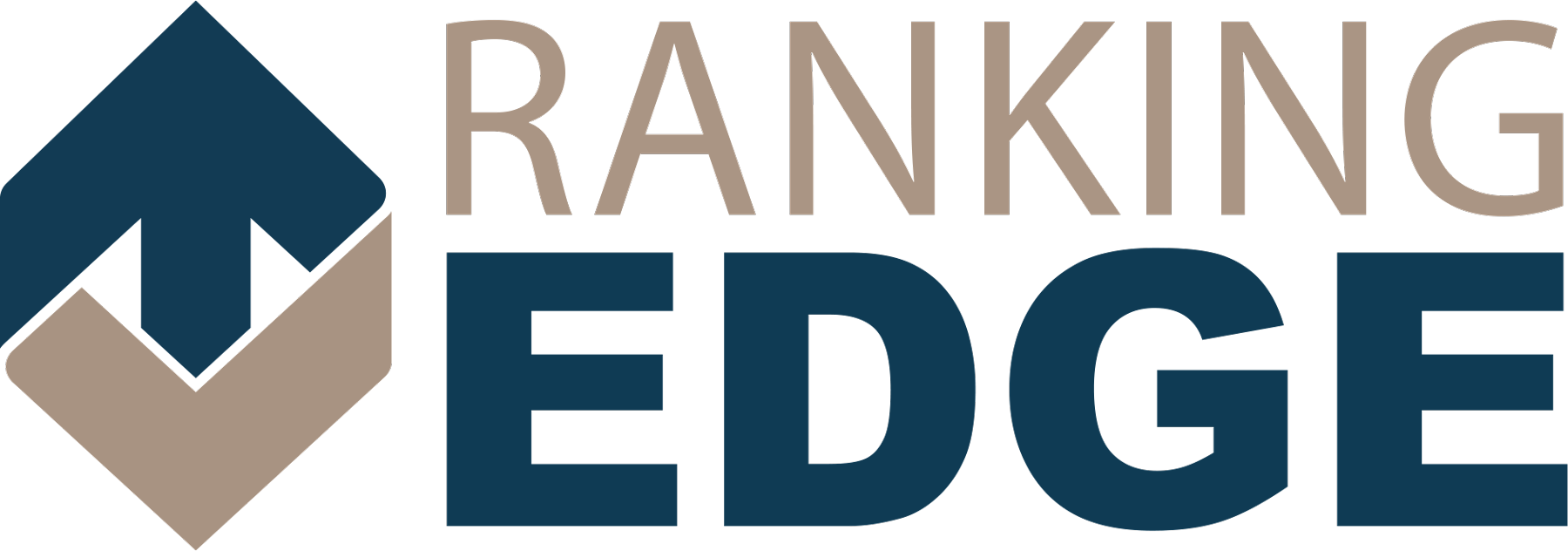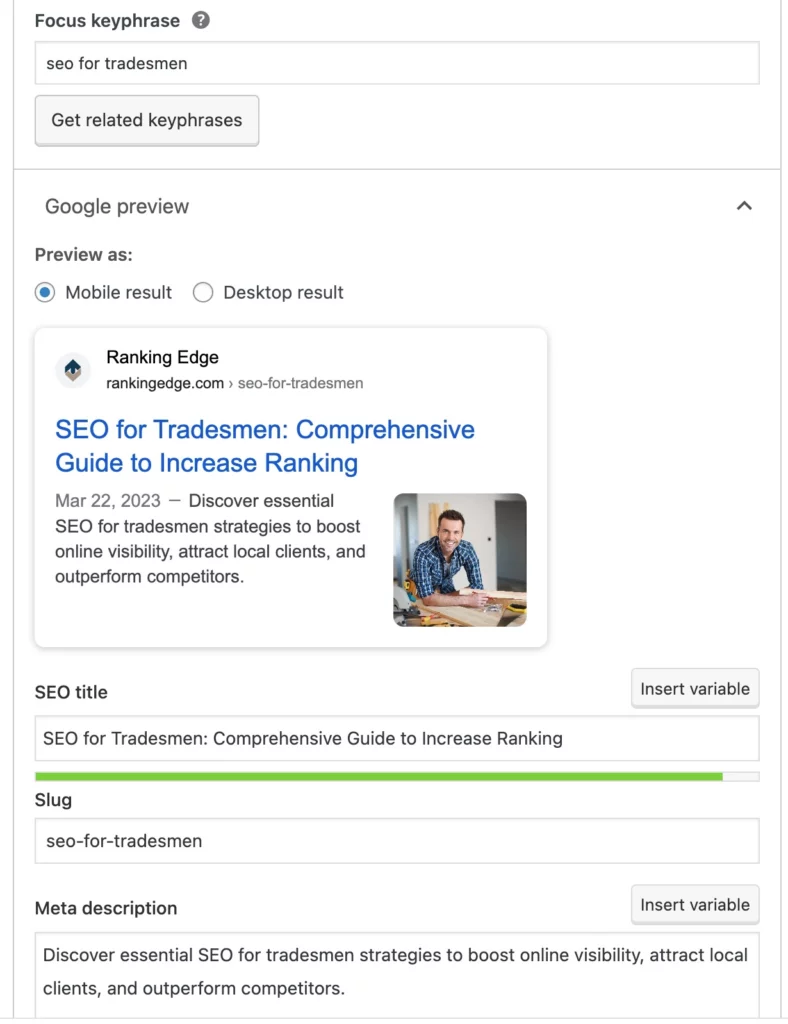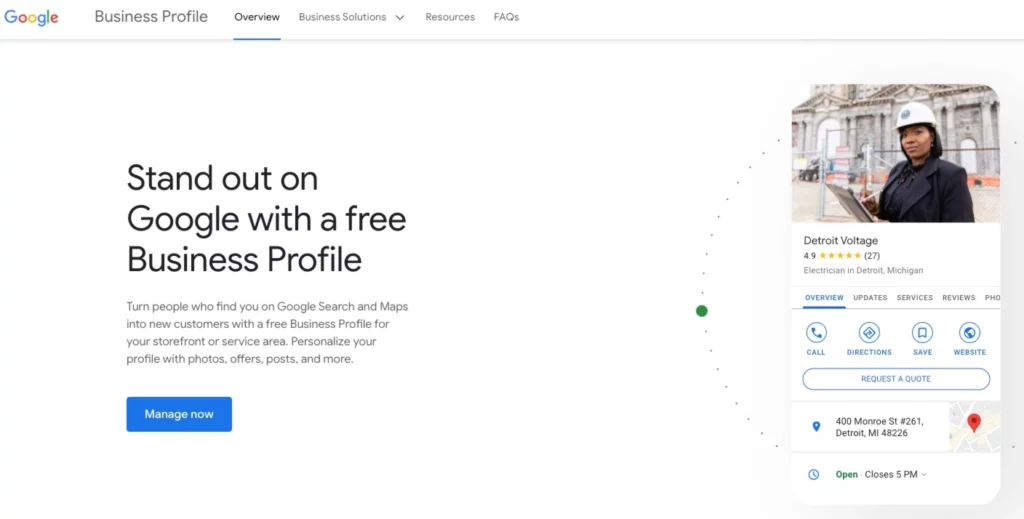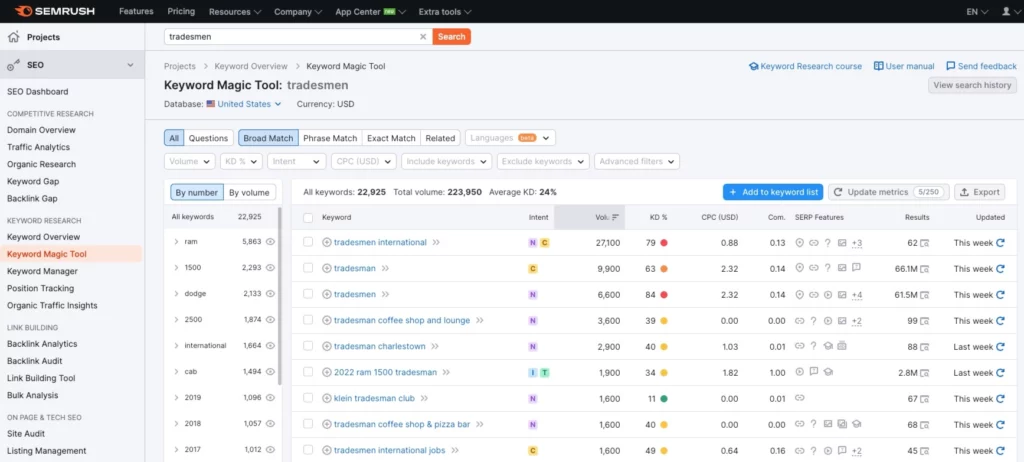SEO for tradesmen has become increasingly important in today’s highly competitive and digital landscape.
As potential clients turn to search engines to find service providers, tradesmen and contractors must ensure a strong online presence to avoid losing business to competitors.
By implementing effective search engine optimization (SEO) strategies, tradesmen can boost their online visibility, attract more clients, and ultimately grow their businesses.
This comprehensive guide aims to help tradesmen understand the importance of SEO. You will learn how to apply best practices to achieve better search engine rankings.
By mastering these strategies and techniques, tradesmen can significantly enhance their online presence and stay ahead of the competition.
Why is SEO for Tradesmen Important?
Increasing Online Visibility
In the digital age, having a strong online presence is crucial for businesses in every industry. For contractors, improving your website’s search engine rankings directly translates to increased visibility among potential clients.
When your website appears on the first page of search results, you’re more likely to be contacted by people looking for your services. SEO is the key to achieving better rankings, which ultimately leads to more inquiries and business opportunities.
Benefits of increased online visibility:
- More website traffic
- Higher conversion rates
- Greater brand exposure
Attracting Local Customers
For many contractors, the bulk of their business comes from local clients. Implementing local SEO strategies helps you to target potential customers in your service area.
By focusing on local keywords and optimizing your online presence for your specific location, you can attract clients who are actively searching for your services in their area.
Staying Competitive in the Digital Marketplace with SEO for Tradesmen
As more and more businesses invest in online marketing, the competition for visibility in search results continues to grow. To stay ahead of your competitors, it’s essential to have an effective SEO strategy in place.
By optimizing your website for search engines, you can ensure that your business remains competitive in the ever-evolving digital marketplace.
Building Brand Reputation and Trust
When your website consistently appears at the top of search results, potential clients are more likely to view your business as an industry leader.
High search engine rankings signal that your website is trustworthy and relevant to users’ queries, which can significantly boost your brand reputation.
By investing in SEO, you can establish your business as a reliable and professional service provider. This makes it easier for potential clients to choose you over your competitors.
SEO for Tradesmen: Understanding the Basics
Before diving into specific strategies and techniques, it’s essential to have a solid understanding of the basic components of SEO for tradesmen. These components include keyword research and targeting, on-page SEO, off-page SEO, and technical SEO.
By mastering these fundamentals, you’ll be well-equipped to optimize your website and improve your search engine rankings.
Keyword Research and Targeting
Keyword research is the process of identifying the words and phrases that potential clients use to search for your services. By targeting these keywords, you can ensure that your website appears in search results when users are looking for businesses like yours.
Steps to conduct keyword research:
- Identify your target audience and their needs
- Generate a list of potential keywords related to your services
- Use keyword research tools to find search volume and competition data
- Select a mix of high-volume, low-competition, and long-tail keywords
- Incorporate the chosen keywords into your website content
On-Page SEO Elements
On-page SEO refers to the optimization of individual web pages to improve their search engine rankings. This includes optimizing various elements of your website, such as title tags, meta descriptions, headings, and content.
Key on-page SEO elements to optimize:
- Title tags: Create unique and descriptive titles for each page
- Meta descriptions: Write concise and informative summaries of your pages
- Headings: Use headings (H1, H2, H3) to structure your content and include keywords
- Content: Create high-quality, engaging content that incorporates your target keywords
Off-Page SEO
Off-page SEO focuses on the factors outside your website that can impact your search engine rankings. This includes activities such as building backlinks, engaging on social media, and establishing partnerships with other websites.
Off-page SEO strategies:
- Build high-quality backlinks from relevant and authoritative websites
- Engage with your audience on social media platforms
- Collaborate with other businesses or websites for guest posting or content partnerships
Technical SEO
Technical SEO involves optimizing the backend of your website to improve its performance and user experience. This includes factors such as site speed, mobile optimization, and overall website structure.
Key aspects of technical SEO:
- Site speed: Optimize your website for fast loading times
- Mobile optimization: Ensure your website is responsive and user-friendly on mobile devices
- Website structure: Create a logical and easy-to-navigate structure for your site
- Sitemap and robots.txt: Set up a sitemap and robots.txt file to help search engines crawl your site efficiently
Key Skills Needed for Effective SEO for Tradesmen
To successfully implement SEO for tradesmen, it’s essential to develop a set of core skills that will help you navigate the ever-changing world of search engine optimization.
These key skills include keyword research and analysis, content creation and optimization, link building and outreach, and analytics and data interpretation.
Keyword Research and Analysis
Mastering keyword research and analysis is crucial for identifying the terms and phrases that potential clients use to find your services. By understanding which keywords are relevant and valuable to your target audience, you can optimize your website content to attract more organic traffic.
Key aspects of keyword research and analysis:
- Understanding search intent
- Identifying long-tail and short-tail keywords
- Using keyword research tools (e.g., Google Keyword Planner, SEMrush)
- Analyzing keyword competition and search volume
Content Creation and Optimization
Creating and optimizing high-quality content is at the heart of any successful SEO strategy. Your content should be engaging, informative, and relevant to your target audience, while also incorporating your target keywords.
Important aspects of content creation and optimization:
- Writing clear, concise, and engaging content
- Including keywords naturally and strategically throughout your content
- Formatting your content for easy readability (e.g., using headings, bullet points, and short paragraphs)
- Optimizing images and multimedia (e.g., using descriptive file names, alt text)
Link Building and Outreach
Building a strong backlink profile is essential for improving your website’s search engine rankings. By establishing relationships with other websites and generating high-quality backlinks, you can boost your website’s authority and credibility in the eyes of search engines.
Link building and outreach strategies:
- Identifying relevant and authoritative websites to target for backlinks
- Creating valuable, shareable content that others want to link to
- Reaching out to other websites for guest posting opportunities
- Engaging in online communities and forums related to your industry
Analytics and Data Interpretation
To measure the success of your SEO efforts and make data-driven decisions, it’s essential to develop skills in analytics and data interpretation. By analyzing key performance indicators (KPIs) and user engagement metrics, you can identify areas of improvement and adjust your strategy accordingly.
Key aspects of analytics and data interpretation:
- Familiarity with SEO analytics tools (e.g., Google Analytics, Google Search Console)
- Understanding and tracking KPIs (e.g., organic traffic, bounce rate, conversion rate)
- Analyzing user engagement metrics (e.g., time on page, pages per session)
- Identifying trends and patterns to inform future SEO strategies
The Importance of Blogs and Blog Posts for Tradesmen SEO
Blogs play a vital role in enhancing the SEO efforts of tradesmen and contractors. By regularly publishing informative and engaging blog content, you can improve your website’s search engine rankings, attract more potential clients, and establish yourself as an expert in your trade.
How Blogs Improve SEO for Tradesmen
Blogs contribute to your SEO success in several ways:
- Fresh content: Regularly updating your blog signals to search engines that your website is active and up-to-date, which can positively impact your rankings.
- Keyword targeting: Blog posts provide an opportunity to target relevant keywords and long-tail phrases that potential clients may use in their searches.
- Internal linking: Blog posts enable you to create internal links, which can improve your website’s overall structure and help search engines better understand your content.
- Backlink opportunities: High-quality blog content can attract backlinks from other websites, increasing your site’s authority and credibility.
Tips for Creating High-Quality Blog Content
To make the most of your blog, it’s essential to create engaging and informative content:
- Write for your target audience: Focus on addressing the needs, questions, and pain points of your potential clients.
- Be informative and helpful: Offer valuable insights, tips, and advice related to your industry or services.
- Maintain a consistent posting schedule: Regularly updating your blog helps keep your website fresh and encourages readers to return.
- Use various content formats: Experiment with different formats, such as how-to guides, case studies, or interviews, to keep your blog interesting and engaging.
Integrating Keywords into Blog Posts for SEO for Tradesmen
To optimize your blog posts for SEO, strategically incorporate your target keywords:
- Include keywords in your blog post title, headings, and meta description.
- Use your target keywords naturally throughout your content, without overstuffing or forced repetition.
- Optimize your images with descriptive file names and alt text containing relevant keywords.
- Focus on long-tail keywords and phrases, which can help attract more targeted and qualified traffic.
Using the Yoast SEO Plugin for Titles, Keywords, and Meta Descriptions
The Yoast SEO plugin is a popular and user-friendly tool for optimizing your website’s content for search engines.
Available for WordPress websites, the plugin makes it easy to manage your titles, keywords, and meta descriptions, ensuring that your content is optimized for better search engine rankings.
The Yoast SEO Plugin has a free version available in the WordPress plugin repository. Yoast also has a Premium paid version. But for most purposes, the free version works fine!
Adding Titles with Yoast SEO
A well-crafted title is crucial for both attracting user attention and improving your search engine rankings. The Yoast SEO plugin provides an easy-to-use interface for creating and editing your titles.
To add or edit a title using Yoast SEO:
- Install and activate the Yoast SEO plugin on your WordPress website.
- Navigate to the page or post you want to optimize.
- Scroll down to the Yoast SEO meta box below your content editor.
- Click on the “Title” field and enter your desired title.
- Make sure to include your target keyword in the title and keep it within the recommended character limit (usually under 60 characters) for optimal visibility in search engine results.
Adding Keywords with Yoast SEO
The Yoast SEO plugin allows you to set a focus keyword for each page or post on your website. This helps you ensure that your content is properly optimized for your target keyword.
To add a focus keyword using Yoast SEO:
- In the Yoast SEO meta box, locate the “Focus keyphrase” field.
- Enter your target keyword or keyphrase in the field.
- The plugin will analyze your content and provide real-time feedback on how well your content is optimized for the focus keyword, including suggestions for improvement.
Adding Meta Descriptions with Yoast SEO
Meta descriptions provide a brief summary of your content, which can entice users to click on your website in search engine results. With Yoast SEO, adding and editing meta descriptions is a straightforward process.
To add or edit a meta description using Yoast SEO:
- In the Yoast SEO meta box, click on the “Meta description” field.
- Enter your desired meta description, ensuring that it accurately summarizes your content and includes your target keyword.
- Keep your meta description within the recommended character limit (usually under 160 characters) to avoid truncation in search engine results.
By leveraging the Yoast SEO plugin’s features, you can effectively optimize your website’s titles, keywords, and meta descriptions, contributing to better search engine rankings and increased visibility for your tradesmen or contractor business.
Promoting Blog Content and Engaging with Readers
To maximize the benefits of your blog, actively promote your content and engage with your audience:
- Share your blog posts on your social media platforms and encourage your followers to engage with your content.
- Respond to comments and questions from readers, fostering a sense of community and building trust.
- Reach out to other industry professionals or websites for guest posting or content collaboration opportunities.
- Use email marketing to share your latest blog posts with your subscribers and encourage them to share your content with their networks.
Tradesman SEO: Best Practices for Local and Niche Markets
For tradesmen and contractors, focusing on local and niche markets can be an effective way to attract potential clients and grow their businesses. By implementing SEO best practices tailored to local and niche markets, you can increase your online visibility and make it easier for customers in your service area to find you.
Optimizing Google My Business Listings
A Google My Business (GMB) listing is an essential tool for local SEO. It helps your business appear in local search results and provides potential clients with essential information about your services, hours, and location.
To optimize your GMB listing:
- Claim and verify your listing: Visit the Google My Business website and follow the prompts to claim and verify your business.
- Complete your profile: Fill out all relevant information, including your business name, address, phone number, website, and hours of operation.
- Add high-quality images: Showcase your work and give potential clients a glimpse into your business by adding professional photos to your listing.
- Collect reviews: Encourage satisfied customers to leave reviews on your GMB listing, as positive reviews can improve your search ranking and attract more clients.
Local Keyword Targeting for the Best SEO for Tradesmen
Targeting local keywords helps you attract customers in your service area who are actively searching for your services. To optimize your content for local searches:
- Identify location-specific keywords: Combine your target keywords with the names of the cities, towns, or neighborhoods where you offer services.
- Optimize your content: Incorporate local keywords into your website content, titles, meta descriptions, and image alt text.
- Create location-specific pages: If you serve multiple locations, create separate pages on your website for each area, including unique content and local keywords.
Building Local Citations and Backlinks
Local citations and backlinks are essential for improving your website’s authority and credibility in the eyes of search engines.
- Build local citations: List your business on reputable online directories, such as Yelp, Yellow Pages, and Angie’s List. Ensure your name, address, and phone number (NAP) information is consistent across all listings.
- Pursue local backlinks: Reach out to local businesses, industry associations, or community organizations for guest posting, sponsorship, or partnership opportunities that could result in backlinks.
Engaging with the Local Community
Connecting with your local community can help you build brand awareness and improve your online reputation.
- Attend community events: Participate in local events, trade shows, or fairs to showcase your services and network with potential clients.
- Collaborate with local businesses: Partner with other local businesses for joint promotions or events, building relationships and boosting your online presence.
- Leverage social media: Use your social media platforms to share news about local events, promotions, or community initiatives, and engage with your local audience.
By implementing these best practices for local and niche markets, tradesmen can optimize their SEO efforts, attracting more clients and growing their businesses in their target service areas.
How to Optimize Your Website for SEO for Tradesmen
To ensure the success of your tradesman SEO efforts, it’s crucial to optimize your website for both search engines and users.
A well-optimized website will not only rank higher in search results but also provide a better experience for potential clients, increasing the chances of converting them into customers.
User-Friendly Website Design
A user-friendly website design makes it easy for visitors to navigate and find the information they’re looking for. To achieve this:
- Use a clean and simple layout: Avoid clutter and unnecessary elements that may distract users from your content.
- Ensure easy navigation: Organize your pages into clear categories and include a navigation menu that’s visible on all pages.
- Use readable fonts and colors: Choose fonts and colors that are easy to read and visually appealing.
- Include clear calls-to-action (CTAs): Guide users towards taking the desired actions, such as contacting you, requesting a quote, or booking a service.
Mobile Optimization
With the increasing number of users accessing the internet through mobile devices, it’s essential to ensure that your website is mobile-friendly.
- Use a responsive design: Implement a responsive design that adapts to different screen sizes and devices, providing a seamless browsing experience.
- Optimize page load speed: Compress images and use caching and other techniques to minimize loading times for mobile users.
- Simplify navigation: Make sure your mobile navigation is easy to use, with large, touch-friendly buttons and a simple menu structure.
- Test on various devices: Regularly test your website on different devices and browsers to ensure optimal performance and usability.
Internal Linking Structure
An effective internal linking structure helps search engines understand your content and improves the user experience by guiding users to relevant pages.
- Use descriptive anchor text: Incorporate keywords and descriptive phrases in your anchor text to indicate the content of the linked page.
- Link to related content: Create internal links between pages with related content, helping users find more information on a specific topic.
- Avoid excessive linking: Don’t overdo internal linking, as it may dilute the value of your links and make your content harder to read.
- Use a logical hierarchy: Organize your content into a clear hierarchy, making it easy for users and search engines to understand the structure of your website.
Optimizing Images and Multimedia
Optimizing your images and multimedia content can improve your website’s load speed and enhance your SEO efforts.
- Compress images: Use image compression tools to reduce file sizes without sacrificing quality.
- Use descriptive file names: Name your image files with relevant keywords, making it easier for search engines to understand their content.
- Include alt text: Add descriptive alt text to your images, which provides a text alternative for users with visual impairments and helps search engines understand your images.
- Use appropriate file formats: Choose the right file format for your images, such as JPEG for photographs and PNG for graphics with transparent backgrounds. If you have Photoshop or other programs that allow you to save image files as WebP, definitely do that.
By following these optimization tips for SEO for trades, you can create a website that ranks higher in search engine results. Secondly, it provides a better experience for your potential clients.
Content Strategies for SEO for Tradesmen
A well-planned content strategy is essential for tradesman SEO success. By consistently producing high-quality, engaging content that appeals to your target audience, you can improve your search engine rankings, drive more traffic to your website, and ultimately grow your business.
Developing a Content Plan
A solid content plan helps you stay organized, maintain a consistent posting schedule, and ensure your content remains relevant to your audience. To develop a content plan:
- Identify your target audience: Understand the needs, preferences, and pain points of your potential clients to create content that resonates with them.
- Conduct keyword research: Use keyword research tools to identify relevant keywords and phrases that your audience is likely to search for.
- Brainstorm content ideas: Generate a list of topics that address your audience’s needs and align with your target keywords.
- Create a content calendar: Schedule your content ideas in a calendar, allocating sufficient time for research, writing, editing, and promotion.
Balancing Evergreen and Topical Content for Best Practice SEO for Tradesmen
Striking a balance between evergreen and topical content helps keep your website fresh and relevant while providing long-term value to your audience.
- Evergreen content: Create content that remains relevant over time, such as how-to guides, FAQs, or industry best practices.
- Topical content: Produce content that addresses current events, trends, or news in your industry. This can attract immediate attention and engagement.
Incorporating Various Content Formats
Using different content formats can make your website more engaging and appealing to a wider audience. Consider incorporating:
- Text: Blog posts, articles, and case studies are excellent for conveying detailed information and showcasing your expertise.
- Video: Create instructional videos, client testimonials, or project walkthroughs to provide a visual representation of your services.
- Infographics: Use visually appealing infographics to present complex data or processes in an easily digestible format.
- Podcasts: Share your industry knowledge and insights through podcast episodes, which can be consumed on-the-go by your audience.
Guest Posting and Content Partnerships to Help Your SEO for Tradesmen
Collaborating with other businesses, industry professionals, or influencers can expand your reach and improve your online reputation.
- Identify potential partners: Look for websites, blogs, or influencers in your industry or niche that share a similar target audience.
- Pitch guest posts: Offer to write high-quality, original content for their website, including a link back to your site.
- Collaborate on content: Work with other businesses or professionals to create joint content, such as interviews, webinars, or co-authored articles.
- Share and promote each other’s content: Leverage your respective audiences and social media channels to cross-promote content and reach a broader audience.
By implementing these content strategies for tradesman SEO, you can create engaging, high-quality content that attracts potential clients and boosts your website’s search engine rankings.
Using SEMRush for Keyword Research: A Recommended Tool
SEMRush is a powerful and versatile digital marketing tool that offers a wide range of features, including keyword research. We use SEMRush for all of our keyword research!
As a tradesman looking to improve your SEO, we highly recommend using SEMRush to identify and analyze the keywords that are most relevant to your business and target audience.
Here’s how you can use SEMRush for your keyword research:
Getting Started with SEMRush
- Visit the SEMRush website and sign up for an account. They offer a free trial for new users, as well as various paid plans with additional features and capabilities.
- Once you’ve created an account and logged in, navigate to the “Keyword Magic Tool” under the “Keyword Analytics” section in the main menu.
Conducting Keyword Research
- Enter your seed keyword: Type a seed keyword related to your trade or services in the search bar and click “Search.” This will generate a list of related keywords and phrases. In addition, it provides with essential metrics such as search volume, keyword difficulty, and more.
- Filter your results: Use the filters provided by SEMRush to refine your keyword list based on specific criteria, such as search volume, keyword difficulty, or word count.
- Analyze keyword metrics: Evaluate the keywords in your list by considering their search volume (the number of monthly searches), keyword difficulty (how competitive the keyword is), and cost-per-click (CPC) data (how much advertisers are willing to pay for each click).
- Identify long-tail keywords: Long-tail keywords are longer, more specific phrases that often have lower search volumes but higher conversion rates. Look for long-tail keywords that are relevant to your business. These have lower keyword difficulty scores, making them easier to rank for.
Exporting and Organizing Your Keywords
- Export your keyword list: Once you’ve identified a list of relevant keywords, you can export the data to a CSV or Excel file for further analysis and organization.
- Organize your keywords: Group your keywords by topic or theme, which will help you plan and create targeted content around these keywords.
- Monitor your keyword performance: Use SEMRush’s “Position Tracking” tool to track your website’s ranking for your target keywords over time. This will help you measure the effectiveness of your SEO efforts and make adjustments as needed.
By using SEMRush for keyword research, you can gain valuable insights into the keywords that will have the most significant impact on your tradesman SEO strategy.
With this information, you can create targeted content that appeals to your audience. You will drive more traffic to your website and ultimately grow your business.
Measuring Your SEO for Tradesmen Success
To ensure your tradesman SEO efforts are effective, it’s essential to measure your success and make data-driven decisions. By monitoring key performance indicators (KPIs), analyzing traffic and user engagement data, and adjusting your strategy based on results, you can continuously improve your SEO and stay ahead of industry trends and algorithm changes.
Key Performance Indicators (KPIs) for your SEO for Tradesmen
KPIs are metrics that help you evaluate the success of your SEO strategy. Some crucial KPIs to track include:
- Organic search traffic: The number of visitors coming to your website through search engines.
- Keyword rankings: The position of your website in search engine results pages (SERPs) for your target keywords.
- Click-through rate (CTR): The percentage of users who click on your website’s link after seeing it in the SERPs.
- Bounce rate: The percentage of users who leave your website after viewing only one page.
- Conversion rate: The percentage of visitors who complete a desired action on your website, such as contacting you or requesting a quote.
Analyzing Traffic and User Engagement Data
Use tools like Google Analytics to gather data on your website’s traffic and user engagement. Key insights to look for include:
- Traffic sources: Understand where your visitors are coming from (organic search, social media, referrals, etc.).
- Most popular pages: Identify the pages on your website that receive the most traffic and engagement.
- User behavior: Analyze how users interact with your website, including time spent on each page, click patterns, and navigation paths.
- Demographic data: Gather information about your website visitors, such as location, age, and device usage, to better target your SEO efforts.
Adjusting Your SEO for Tradesmen Strategy Based on Results
Regularly review your KPIs and website data to identify areas for improvement and adjust your SEO strategy accordingly. For example:
- Optimize underperforming pages: Improve the content, keywords, or user experience on pages with high bounce rates or low engagement.
- Build on successful content: Create more content around topics that have resonated with your audience or led to high conversion rates.
- Refine your keyword targeting: Adjust your target keywords based on their performance and ranking potential.
Staying Updated on Industry Trends and Algorithm Changes
Search engine algorithms and industry best practices are continually evolving. Stay informed on the latest trends, news, and algorithm updates by following reputable SEO blogs, attending industry conferences, or participating in online forums.
By regularly measuring your SEO success and making data-driven decisions, you can refine and improve your tradesman SEO strategy to attract more clients and grow your business.
Final Thoughts and Conclusion on SEO for Tradesmen
A well-executed SEO strategy can significantly increase your online visibility, attract local customers, and help you stay ahead of the competition.
Throughout this article, we’ve discussed various strategies and techniques, such as keyword research, content creation, website optimization, and performance measurement, that can make a tangible impact on your business’s success.
We encourage you to implement the strategies and techniques discussed in this article and continually refine your SEO efforts based on data and performance. Remember, SEO is not a one-time effort but an ongoing process that requires consistent attention and adaptation.
Take the time to further your learning and stay updated on industry trends, algorithm changes, and best practices. By doing so, you’ll be well-equipped to navigate the ever-changing world of SEO and continue to grow your business in the digital age.
Now is the time to take action and harness the power of SEO for your tradesman business.









